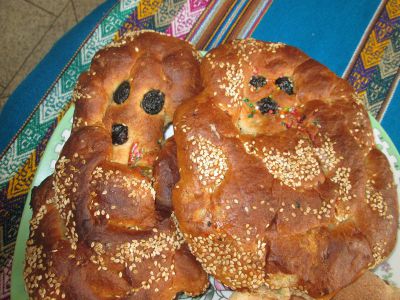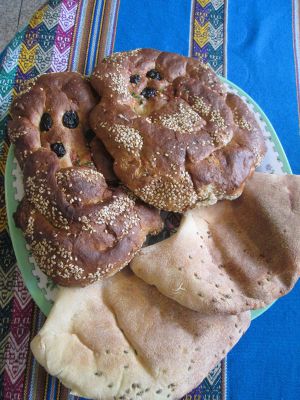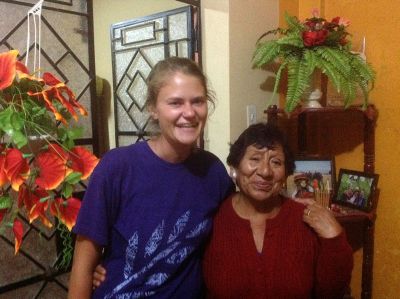Pan (Bread)
Joanna shares a journal entry:
“Sin pan, no vive.” (“You can’t live without bread.”)
Ercilia Gonzales Pincos, Joanna’s host mother

There is such complexity in bread. Everywhere, bread holds great significance; it is a staple of all cuisines in one form or another, and the word itself is laden with meaning and connotation. In Perú, in the Huamanga province, in the city of Ayacucho, bread is everything.
I have been asking people on the street, “¿Qúe tipo del pan le gusta mas? ¿Come el pan todos los dias?” The answer to the first question (What kind of bread do you like best?) varies; the answer to the second (Do you eat bread every day?) never does. It is a simple “Si,” usually accompanied by a little chuckle, which seems to imply an unspoken question: Who doesn’t?
There are two distinct camps of bread eaters in Ayacucho. There are those who favor pan frances, the ciabatta, the baguette, the crispy, crackly crust and the chewy, flavor-dense crumb. I spoke to a man at Perú Pan, a little bakery located on Avenida 26 de Enero, with the slogan “El arte de hacer pan” (“The art of making bread”).
This bakery produces primarily pan frances. They do not have the correct ovens to make the traditional Ayacuchan breads. The man I talked to told me that ciabatta and baguettes are their top sellers, and overall this small bakery with two full-time bakers produces between 1,000 and 2,000 breads a day.
My host mother does not like these breads, the pan frances. She tells me they are nice on the day they are baked, but any days following, they are tough and too hard to chew. “¡Que feo!” (“How nasty!”), she exclaims, making a face that is both mournful and disgusted at the same time. “¡Que feo!” is one of my mother’s favorite expressions to describe almost anything. Her workday, the rain, French cheese: “¡Que feo!”

My mother’s bread of choice, and that of many other native Ayacuchans, are the traditional breads that originate right here in the Huamanga province. Two of these that seem to be most popular are pan chapla, my mother’s favorite, and tanta wawa or just wawa. I also love chaplas and wawa.
As I enjoy a chapla con mantequilla y miel (chapla with butter and honey) for breakfast, I determine pan chapla to be my favorite. But then I tear off a piece of the sweet, dark wawa, which I take with my coffee, and I think that wawa must be my favorite. It seems that I am torn.
Part of the reason that I love the chaplas and wawas is because of their rich history. Everyone I talk to knows about them, and everyone’s information on the breads and their history will be a little bit different. To me, I would expect nothing else from a Peruvian.

Pan chapla was one of the first breads, and indeed, foods, that I consumed in Ayacucho. My third day in town, and my first day at the comedor, my mother came to fetch me at the end of the workday. We caught the No. 12 bus at the exact corner where it had dropped us off in the morning. This turned out to be a mistake.
Bus No. 12, it seems, has a route that is just one big loop. Twenty minutes later the number of passengers on the bus had been reduced to the two of us, the bus had stopped for the driver and the cobrador to purchase sodas, and we were somewhere out in the boonies (“Arriba, arriba,” my mother said. “¡Que feo!”).
It was around this time that we again crossed Avenida 26 de Enero — about five blocks down from where we had gotten on the bus 30 minutes earlier. In the future, my mother advised me, better to walk and catch the bus here.
Finally, the bus dropped us at what I was told would be my stop, la posta. My head was buzzing with new information and noise as I desperately tried to place a mental bookmark on this unfamiliar looking place, visions of getting off at the wrong stop and becoming lost flashing before my eyes. I followed my mother down the road. We turned and walked up a steep street, passing two women sitting along the road sifting through a massive amount of quinoa laid out on tarps. One woman wore the traditional Andean garb. The other wore blue leggings and a stained white T-shirt.

We turned into another road and I was sure I would never remember this route home. A large blue truck in front of us blocked the road as the driver executed a series of four-point turns in an effort to turn into a gated driveway off the narrow road.
My mother and I paused to let him finish before we could pass and then, to my immense confusion, she followed the truck into the gated area. We entered a poorly lit room, where she talked with a man standing nearby. She then turned to me. “It will be about 20 minutes. We’ll wait. Shall we wait?” I nodded, completely unsure what I was agreeing to.
We stood off to the side and soon another man began to rapidly bring over long rectangular wooden planks with six or seven small disks of dough on each. Chaplas. We were at an horno, a traditional bakery. The man my mother had just spoken with sprang into action, grabbing a nearby wooden peel with a handle that was probably about nine feet long. With clearly well-honed movements, he slid the chaplas from the planks onto the peel and then with a quick jerk of the peel, they were in the huge wood-fire oven built into the wall.
He continued deftly loading the chaplas to bake, six or seven at a time, as the other man brought more and more planks of dough to him. After three to five minutes, the peel was back in the oven, pulling out freshly baked, puffed-up, warm chaplas. A third man began to sort the chaplas, dusting excess flour off the tops and moving them to a huge cloth-lined basket. For two soles, my mother purchased 12 fresh chaplas.
At home, my mother said, “Tomalos con tu cafecito” (“Enjoy them with your coffee”), as she removed the butter and honey from the fridge, the kettle whistling away on the stovetop. And so we did.




